‘Mababang tingin ni Duterte sa kababaihan’
“Ayaw namin kay Duterte dahil sa hindi maganda at mababa niyang pagtingin sa kababaihan.”—Gert Libang, Vice-Chairperson, Gabriela
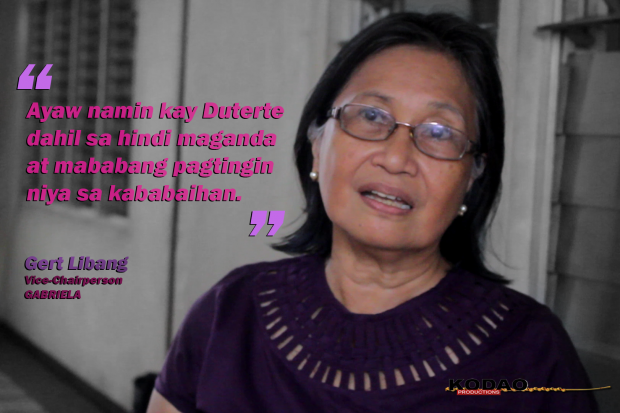
“Ayaw namin kay Duterte dahil sa hindi maganda at mababa niyang pagtingin sa kababaihan.”—Gert Libang, Vice-Chairperson, Gabriela

By Joseph Cuevas
Karapatan and other progressive groups scored the government over recent incidents of harassments and red-tagging of progressive organizations and activists.
Karapatan linked this series of attacks to the alleged ‘Red October’ destabilization plot the military and police said the Communist Party of the Philippines and other groups are about to launch this month.
Karapatan reported that last week, red-tagging incidents by State forces against church leaders and organizations were recorded.
Last September 21, the Karapatan chapter in Cagayan Valley received text messages accusing the organization of being a legal front of the New People’s Army and being “fake humanitarians.”
The group also reported last that last September 29 in Pampanga, a streamer was hung over a bridge in Balibago in Angeles City with a message “Karapatan, terrorist and protector.”
A similar incident happened last September 28 in Zamboanga Del Sur where the perimeter wall of the Iglesia Filipina Independiente (IFI) church in Tigbao town were painted with the words “IFI=NPA”.
“UCCP=NPA, IFI=NPA and Bishop Ablon=NPA” were also painted along the highway of Brgy. Lacupayan in Tigbao.
IFI Bishop Antonio Ablon is the chairperson of Karapatan Western Mindanao.
Legal groups red-tagged
Urban poor group Kalipunan ng Damayang Mahihirap (KADAMAY) also reported harassments against its chairperson Gloria Arellano and public information officer Michael Beltran.
KADAMAY said two police officers asked for their whereabouts at their office in Quezon City but the two leaders were not around at the time.
The unidentified police officer also queried KADAMAY personnel about Arellano and Beltran’s activities.
Organizers and labor leaders of NutriAsia in Meycauayan in Bulacan also reported harassments by police in civilian clothing were roving around the church where workers were staying.
Incidents of rock throwing also happened after workers ran after fleeing motorcycle-riding men believed to be NutriAsia guards casing the area.
The workers said even Meycauayan Police Supt. Santos Mera was seen around the area looking for the labor leaders.
Mera commanded the violent dispersals of striking Nutriasia workers last June 14 and July 31.
Red October canard
Karapatan said that the Duterte regime is hard-selling the alleged ‘Red October’ plot to further justify its human rights violations.
The group cited the killing of a 43-year old Moro Human Rights Worker in Maguindanao last September 23.
“The regime is conjuring its own monsters, triggered by insecurities which stem from its inability to solve the country’s problems,” Karapatan said.
Meanwhile, the Philippine Peace Center (PPC) said that the so-called ‘Red October’ ouster plot is a lie.
“It is a fabrication aimed at preventing the various legal groups from closing ranks and undertaking bigger joint protest actions. It is a part of scheme to red-tag, demonize and stigmatize the more militant and progressive groups as ‘terrorist’ and ‘communist’ as a prelude to ‘neutralizing’ them with more repressive measures,” the PPC said. #
SPECIAL REPORT
By Raymund B. Villanueva
National Democratic Front of the Philippines (NDFP) peace consultant Randy Malayao can only shake his head as he looked at photos of the landslide in Itogon, Benguet last month that reportedly killed 69 residents, majority of whom were miners and their families. Initial reports said the tragedy was brought about by the torrential rains brought about by typhoon “Ompong” that wreaked havoc all over Northern Luzon. Eventually, however, it was accepted that the typhoon only triggered the disaster and that mining activities in the area—both large and small scale—was its main cause.
“It should not have come to this,” Malayao said. “This could have been prevented if only the Manila government listens to the people,” he added.
Since his release from prison as a political detainee in 2012, Malayao has resumed his work as a consultant of the NDFP’s negotiating panel, attending formal negotiations in Europe and reciprocal working group meetings in the Philippines and abroad. As the NDFP’s resource person from Northern Luzon, he is intimate with mining issues in his home region of Cagayan Valley, as well as the Ilocos Region and the Cordilleras. Environmental protection was one of his advocacies that made him a victim of abduction and intense torture in the hands of the Philippine Army. He spent four and a half years inside various jails as a political prisoner.
“The countless discussions I attended on what makes our people poor, especially the peasants, opened my eyes that environmental degradation contributes to their poverty, contrary to what has been promised them for more than a hundred years. Mining activities in Northern Luzon has made its people poorer,” he said.
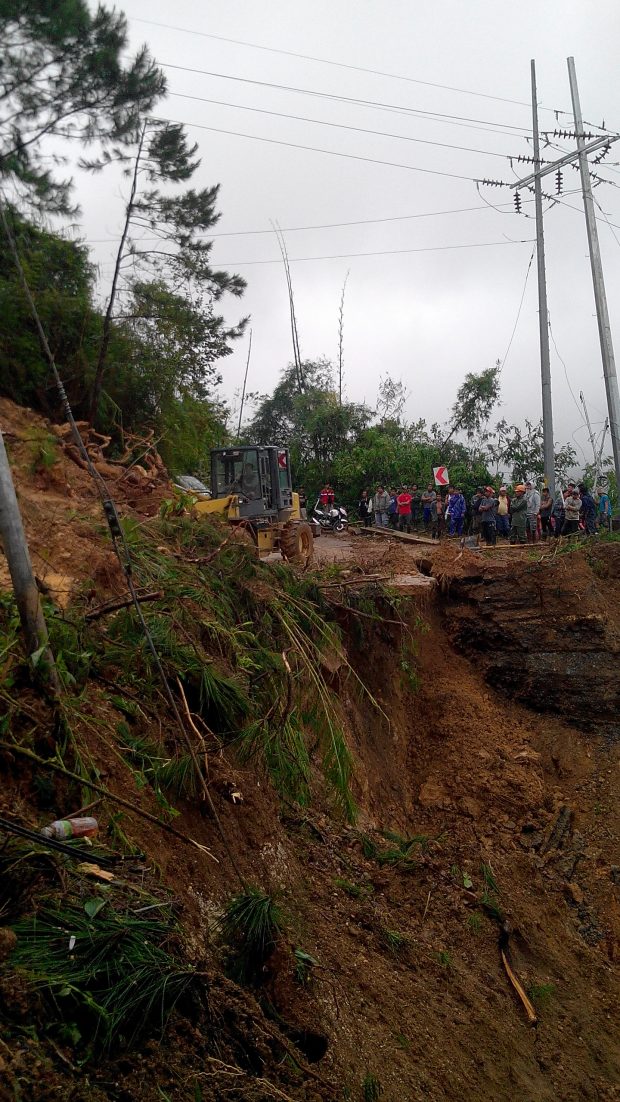
Rescuers try to clear part of the landslide in Barangay Ucab, Itogo, Benguet that killed 69 residents. (Photo by Kim Quitasol)
The victims of the Itogon landslide are a case in point. Malayao said that mining activities, primarily when mining giant Benguet Corporation was active in the area, caused its forest cover to be denuded and its soil unstable. The landslide last month was only the latest in a string of similar incidents and it is unfair to blame the victims who he suspects are allowed to continue their activities with the consent of the company that still owns the mining licenses in the area.
Northern Luzon is one of the Philippines’ mining hotspots. Gold, copper, and molybdenum are mined in Nueva Vizcaya; gold and nickel are extracted in Isabela; gold has been mined in the Cordilleras for hundreds of years, and gold and magnetite (also known as black sand) are mined in the Ilocos Region and Cagayan Province’s coastal and offshore areas. As a mountainous area, the regions are also a prime source of sand and gravel as well as lumber. But despite the nearing depletion of its mineral wealth, it is agriculture that keeps the regions’ economy afloat. While it has enriched a few corporations beyond belief, mining has only kept many of its residents in poverty. Not a few have lost in their lives.
It was because of this situation that the NDFP has pushed for environmental protection, rehabilitation and compensation as one of the top agenda under the substantive issue of social and economic reforms of the peace negotiations between itself and the Government of the Republic of the Philippines (GRP).
CASER and the environment
It was as far back as September 1, 1992 that both the GRP and the NDFP agreed in the document called The Hague Joint Declaration to discuss social and economic reforms to address “the root causes of armed conflict.” Both parties agreed that a Comprehensive Agreement on Social and Economic Reforms (CASER) is a program that could end poverty and other social problems. It was only recently, however, that a section on environmental protection was finally approved, even if the issue had always been on the table for more than 26 years already.
“[NDFP’s] latest version of [its draft] CASER is the result of careful study and analysis started in the middle of 2016. The NDFP Reciprocal Working Committee on Social and Economic Reforms (RWC-SER) looked at the relevant experience and practice of the revolutionary forces in the cities and, especially, the countryside,” the NDFP said in the preface of its book on the peace talks agenda.
As expected, the NDFP had been scathing in its assessment of the state of environment in the
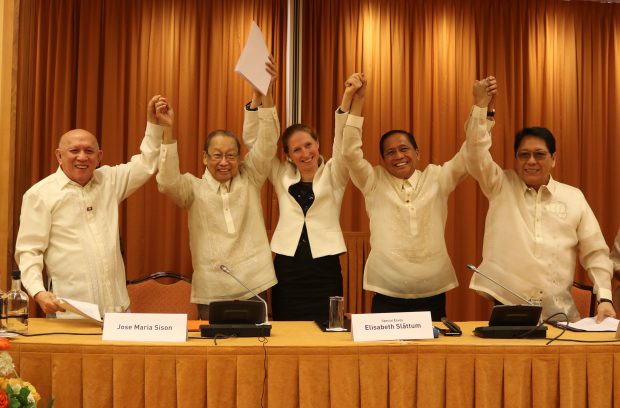
Philippines, especially mining.
“Corporate mining depletes our minerals as well as destroys forests and mountains. National minorities are displaced from their communities and ancestral lands. Critical resources for national industrialization are lost,” the NDFP said. “The profit-driven nature of capitalist production with the particular neo-colonial pattern of production and trade, that overrides social and ecological considerations has been the main factor in the devastation of the Philippine environment and the consequent disasters that have plagued the country,” the NDFP explained.
It may come as a surprise to most, however, that under its CASER proposal, the NDFP is not against mining. Rather, the NDFP says it is for responsible and pro-people mining.
NDFP urges environmental protection with economic development
For the NDFP, mining is not evil. It only becomes so because the environment is being destroyed by current mining practices and it only benefits members of the local ruling elite and foreign economic interests.
The NDFP said that environmental protection, conservation and the wise use of natural resources are necessary components of socio-economic development policies and that ecological balance is integral to national development.
By this, it means two things.
First, current destructive mining practices must be stopped and replaced with more environment-responsive ways. Not a few were surprised when the NDFP expressed full support to former GRP environment secretary Gina Lopez when she ordered the ban on open pit mining and a review of all mining activities nationwide. In turn, Lopez said she was willing to work with the revolutionary New People’s Army (NPA) in protecting the environment. This prompted the NDFP to invite Lopez to attend the NDFP-GRP formal peace negotiations in Europe to present her views the Left said were in accordance with its programs on the environment.
“The desire of Gina Lopez to work with the NPA for peace and development is welcome by the NDFP. It is directly related to the environment, agrarian reform and rural development now being negotiated under the substantive item Comprehensive Agreement on Social and Economic Reforms,” NDFP chief political consultant Sison said. “It will be fine if Gina attends the fifth round of formal talks,” Sison added.
Lopez told Kodao she would accept the invitation provided she would be confirmed by the powerful Commission on Appointments. “Yes, I’ll go,” Lopez said. “What I would want to do is to create models first than just talking. What I would like to do is to work with the NPA and create models where we get people out of poverty in like six months to a year. Then I’ll go talk to him (Sison): ‘Sir, look at what we did here. What if we do these everywhere?’” Lopez explained.
Lopez was eventually rejected by the CA and Duterte decided to not reappoint her controversial environment secretary.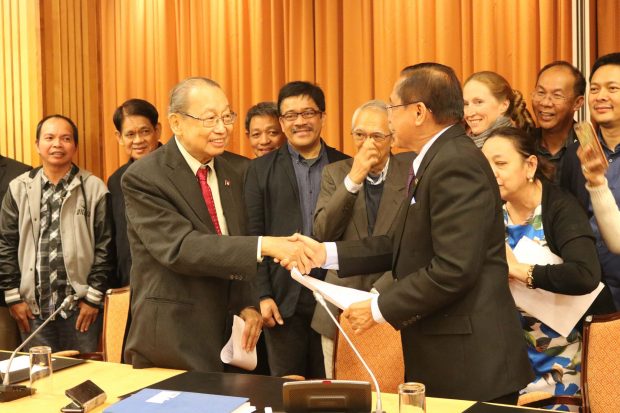
Second, the NDFP wanted that upon signing of the CASER, most of the raw materials from the country’s mining activities would stay in the country to be used for its national industrialization drive. “The strategy of export-led economic growth has opened the country’s natural resource to control and plunder by the foreign monopoly capitalists, big comprador bourgeoisie and bureaucrat capitalists. As the imperialists and the local exploiting classes freely siphon off the nation’s natural wealth, they leave behind a ravaged environment, Industrial wastes like mine tailings and carbon monoxide emissions and unsafe agricultural products pollute and destroy the environment,” the NDFP said.
The group added that existing laws such as the Mining Act of 1995 mean the wholesale delivery of the national patrimony to the unbridled exploitation by foreign investors through the liberalization of the mining industry. They open the door wider to the destruction of the environment and the displacement of the national and ethnic minorities from their ancestral lands.
Under Section 2 of NDFP CASER’s principles of environment protection and economic development, the group proposes that the parties “…commit to pursue economic development with due regard to the protection and efficient use of the country’s renewable and non-renewable resources and to institute measures for ensuring a healthy national environment.”
GRP panel’s ‘surprising’ draft
It was not only the NDFP that sprung surprises in its environment protection drafts of the CASER. The GRP was not to be outdone when it submitted its own environmental protection, rehabilitation, and compensation draft after the fourth round of formal talks in Noordwijk An Zee in The Netherlands in June 2017.
“The GRP’s draft has many provisions similar to NDFP’s. While there are differences between their drafts and ours, there are enough similar provisions that could be the foundation of a favorable agreement on this issue,” an NDFP source told Kodao.
For example, on the issue of mining, the GRP RWC-SER’s draft said that the pursuit of economic development must integrate protection, efficiency, and just use of the country’s resources and ecology, including making sure that the carrying capacity of the environment is not breached.
Taking a cue from the NDFP draft, the GRP draft, under Section 6 of its draft Priority Actions for Sustainable Development and Environmental Justice, says that all mining operations are to be regulated “to ensure domestic processing of mineral resources, guarantee environmental protection and justice, safeguard mine workers, compensate communities for damages, uphold democratic consultation and the consent of communities, allocate mining revenues and benefits equitably, and charge the costs of mine maintenance, disasters and rehabilitation to the revenues of mining firms.”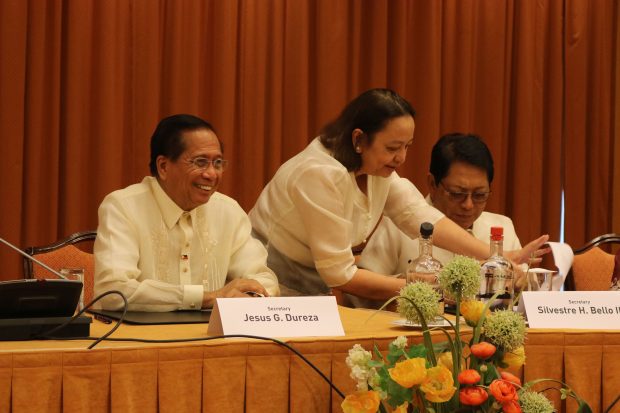
Support from environmentalists
Kalikasan People’s Network for the Environment national coordinator Leon Dulce hailed both the NDFP and GRP negotiators’ respective drafts as steps towards the protection of the environment and national development.
“What both parties have shown is that, at the very least, they were willing to discuss how mining could be more environment-responsive and beneficial to the Filipino people at the same time,” Dulce said.
Kalikasan said the country may have around 7.1 billion metric tons of metallic mineral reserves (such as gold, copper) and nickel) and 51 billion metric tons of non-metallic deposits. “The total revenue of these reserves may be worth US$1 trillion, ten times the country’s gross domestic product and 14 to 17 times larger than its entire external debt,” the group said.
Like the NDFP and GRP’s drafts on environment protection, Kalikasan seeks a reversal of the nature of the country’s mining industry.
“In forums and symposiums organized and attended by Kalikasan, including congressional hearings on the People’s Mining Bill (House Bill 2715, filed by Bayan Muna) that we are suporting, we have always said that the mining industry should be geared towards national industrialization,” Dulce said.
Kalikasan said that the mining industry should be redefined for the production of raw materials—such as base metals, basic chemicals and petrochemicals needed by the basic, medium and heavy industries—to produce as much consumer, intermediate and capital good with the country’s stock of finite mineral and non-mineral industrial raw materials and in the process provide jobs to the country’s vast human resources.
“In other words, our country should not be exporting everything that is mined within our territory because we need them for when we finally industrialize. And that may be possible if the GRP and the NDFP agree to sign a CASER and honestly implement it,” Dulce said.
The environmental activist also clarified that under both the NDFP and GRP drafts of the CASER as well as HB 2715, that the drafts are not necessarily against foreign mining corporations.
“I think these documents clarified that as long as these foreign mining corporations have no bad records and they agree to contribute to national industrialization, they are welcome,” he said. The People’s Mining Bill says that the State shall in cases allow foreign corporations to invest in the mineral industry.
“Based on the National Industrialization Program and the country’s capability and capacity, the government must identify the mineral areas where foreigners can help and invest subject to rigorous screening and strict regulations…The participation of foreign companies in the critical stages of mineral extraction and processing shall be in accordance with a mandatory program or agreement for technology transfer and equity shares that do not exceed 40 percent of the full capital requirements,” HB 2715 reads.
“Alas, the GRP principal (Duterte) is unwilling to continue the talks,” Dulce bewailed.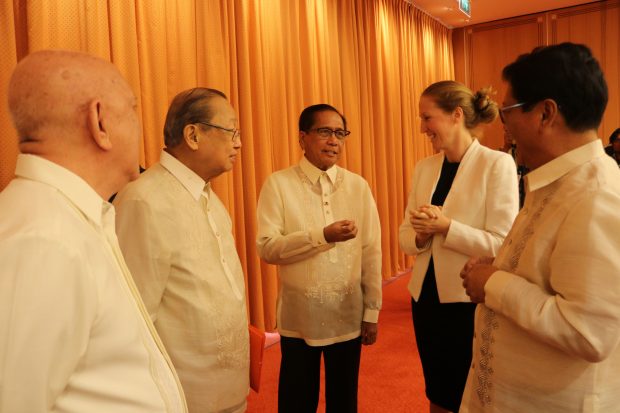
Wasted opportunity
Malayao agrees with Dulce that Duterte is wasting the opportunity to have an environmental protection agreement signed with the NDFP.
“I could not begin to describe to you the hard work put into crafting both the NDFP and GRP drafts on environmental protection under the prospective CASER. It was supposed to have been discussed as early as June 2017 by the negotiating panels,” Malayao said.
A signed agreement between the GRP and the NDFP is a binding and legal document, Malayao explained. Even without a final peace agreement, both the GRP and NDFP can already implement its provisions, as they did with their agreement on human rights and international law when they established a joint monitoring office in 2004.
“If the CASER was signed and implemented last year, perhaps extractive activities in Itogon, as well as in Naga City in Cebu Province, could have been more strictly regulated. Perhaps, the near simultaneous tragedies last month would have been averted,” Malayao said. #
“Iyong Red October plot na inilalako ng gubyerno, kalokohan talaga iyon. Mabuti pa, pag-usapan na lang ang panawagan ng magsasaka dahil ang Oktubre ay Peasant Month.”—Evangeline Hernandez, Chaiperson, Hustisya
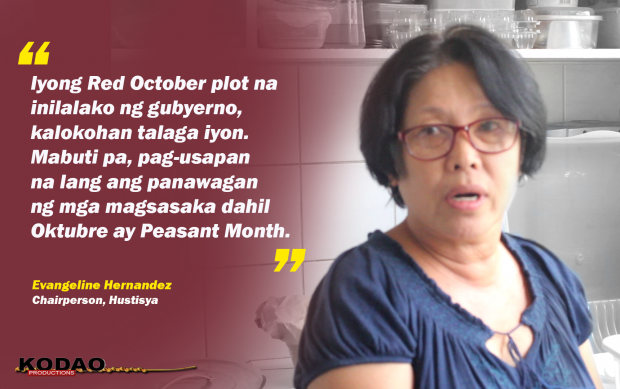
Amid soaring prices, the MWSS Board of Trustees has given the nod to higher water rates for Maynilad Water Systems Inc.
This and impending Manila Water Company, Inc. rate increases are bound to burden consumers anew, said water rights group Water for the People Network (WPN).
WPN urged the Metropolitan Waterworks and Sewerage System-Regulatory Office (MWSS-RO) to suspend the hike so as not to aggravate the difficulty of millions of low-income families in spending for their basic needs.
Approved by the MWSS Board is a Php5.73/cubic meter (cu. m.) hike for Maynilad as proposed by the MWSS-RO.
Meanwhile, the proposed increase for Manila Water rates is Php6.26-Php6.55/cu. m.), which is set for deliberation within the month.
These figures are the supposed results of the rate rebasing process.
Every five years, government determines new water rates according to its review of the water companies’ petitioned rates vis a vis their past and projected expenses throughout the concession period.
Purportedly in consideration of consumers’ inflation woes, the MWSS-RO proposed for the increases to be collected in tranches, starting in October.
Maynilad’s approved rate hike schedule begins at a weighted average of Php0.90/ cu. m.
Manila Water’s rate hike begins at a weighted average of Php1.50.
WPN however said that regardless of the scheduled tranches, any addition to current expenses further constricts spending for poor households.
This includes millions of families whose incomes already fall way below the Php995 Family Living Wage (FLW) for a family of five. The daily minimum wage in the National Capital Region (NCR) totals Php512.
MWSS-RO computes that this October, the bills of households covered by Maynilad will increase by a net amount of Php6.53 for households consuming average 15 cu. m. per month and a net amount of Php13.68 for households consuming average 25 cu. m. per month.
For Manila Water customers consuming the same average volumes of water, rates increase by a net amount of Php9.68 and Php20.30, respectively.
Aside from the basic charge, however, WPN noted that the all-in tariff includes other fees such as the foreign currency differential adjustment (FCDA), environmental charge, and the value-added tax (VAT).
All-in tariffs are already at Php48.03/cu. m. for Maynilad and Php36.40/cu. m. for Manila Water as of July 2018.
The MWSS-RO claimed that Maynilad’s approved rate hike is much lower than the company’s Php11.00 petitioned increase, as is the RO’s recommended increase for Manila Water compared to the latter’s Php8.30 proposed hike.
This supposedly reflects the MWSS’ prohibition of the inclusion of the water firms’ corporate income tax and expenses unrelated to water services such as donations and recreation.
WPN however said that the agency’s refusal to publicly show the documents proving this–prior to the approval of the MWSS Board–underscores that the rate rebasing process lacks transparency and authentic public consultation.
During the 2013 rate rebasing process, public clamor versus the discovered inclusion of such items in water bills led to the MWSS-RO’s rejection of the water concessionaires’ petitioned rates.
Thus, per their concession agreement (CA) with the government, Maynilad and Manila Water subsequently appealed to international arbitration courts to demand compensation for lost revenues.
The courts have ruled twice in favor of Maynilad. Manila Water, which the international courts have turned down, has a pending case.
Consumers face more tariff increases in the future, WPN said, because of government’s privatization of water despite its being a public utility.
The group challenged the MWSS-RO to spare consumers of additional fees by stopping the hike.
WPN also stressed the urgency of scrapping the CA, reversing water privatization and instituting strong government regulation over all public utilities. #
Ni Ibarra Banaag
Sana’y di nagkamali sa treno’ng inyong sinakyan.
Nakakaaliw man at nakakabingi ang hagikgikan.
Ang sumakay ay di libre bagkus ay babayaran.
Ng buwis at inutang sa kawatang dayuhan.
Sana ay may preno ito sa pag-arangkada.
At ng di rumagasa sa mga barong- barong.
Malimas, madambong, pilak, gas at ginto.
Habang pinapatag matatayog na bundok.
Hiling ko sa pasahero ng Train 1 at 2.
Dumungaw naman kayo sa bintana ng bagon.
Masdan ninyo ang pumipila sa palabigasan.
Habulin niyo ng tingin ang mga Inang luhaan.
Sana’y maalimpungatan sa liliw ng bangungot.
Hindi dilaw ang buhay at dugo na nangalalagas.
Hindi pula ang naghahangad ng pagkawasak
Kundi ang uring sumasaklot sa katarungan.
Sa tuloy tuloy na pagragasa ng inyong tren.
Hindi lang puno ang nabubuwal kundi buhay.
Hindi lang ilog ang natutuyo kundi lalamunan
Hind lang burol ang napapatag kundi komunidad.
Hindi kalaban sa politika ang nakukulong.
Ang nasa piitan ay demokrasya at kamangmangan.
Hindi katungali sa eleksyon ang nasa bilibid.
Kundi ang kalayaan sa isang makatarungan lipunan.
Ako sa inyo ay may isang panalangin.
Na ‘wag maunsyami ang inyong pagbubunyi.
Kung kayo na ang biktima ng panggigipit.
Tumimbwang at sabihin kayo’y nanlaban.
The Communist Party of the Philippines (CPP) denied repeated claims by the Armed Forces of the Philippines (AFP) of a so-called Red October plot to oust President Rodrigo Duterte by October.
The CPP said the AFP conjured the fictional plot only to set the stage for the Duterte government’s draconian measures against the people.
“This so-called Red October plot is nothing but an AFP invention. Like the rest of the AFP’s fakery, it is a poorly concocted story. They came up with this ‘intelligence information’ as early as July,” the CPP in a statement said.
The group challenged Duterte and the AFP to show proof especially after Duterte himself recently claimed he is in possession of a recorded phone conversation between the CPP and other groups.
But the AFP continues to push its story as its spokesperson Col. Edgar Arevalo told DZMM Tuesday that so-called legitimate opposition groups such as Tindig Pilipinas and Magdalo refused participation in the plot.
Arevalo cited the groups’ absence at the Rizal Park rally last September 21 commemorating the 46th anniversary of the declaration of martial law by the Ferdinand Marcos dictatorship.
Arevalo claimed that part of the plot involved engaging in massive workers strikes, adding they learned of the plan from digital files and documents recovered from former communist rebels who surrendered.
‘What are Duterte and AFP planning for October?’
The CPP shot back that the real question is not whether there is such a conspiracy but what Duterte and the AFP are plotting for October.
“Is this a foreshadowing of a declaration of martial law by October? Indeed, ‘Red October’ sounds very similar to 1972 claims of a ‘Maoist rebellion’ which Marcos used as justification for declaring martial law and imposing his fascist dictatorship,” the CPP said.
The group said that in hyping up the alleged conspiracy, the clear aim of the AFP is to justify the implementation of increasingly severe measures in the name of “defeating the plot” to target legitimate protest actions which express the sentiments of a disgruntled people.
The revolutionary party said it is very apparent that Duterte and the AFP are increasingly insecure amid the rising economic and political crisis.
The CPP said Duterte has only himself to blame for his regime’s destabilization.
“By turning a deaf ear to the Filipino people’s most urgent demands for an end to the burdensome TRAIN taxes, solution to incessant price increases, wage increases, jobs and job security, as well as their clamor for an end to state terrorism, rampant violations of human rights, narco-politics and bureaucrat capitalist corruption, Duterte is inciting more and more people to rise up in protest and resist his rule,” the CPP said.
‘His own destabilizer’
In a separate statement, the Kilusang Magbubukid ng Pilipinas (KMP) said the so-called Red October plot is an obvious attempt to cover-up legitimate consumer actions and public grievances against frequent price hikes.
“Strong public opinion and actions against high rice prices have heightened during the past months and it really shook up Duterte’s leadership,” KMP secretary general Danilo Ramos said.
Setyembre 21, 2018 – Panoorin ang panayam kay Dan Balusio, Secretary-General ng BAYAN Bikol hinggil sa kalagayan at panawagan ng mamamayan ng rehiyong Bikol tungkol sa Martial Law mula noon hanggang ngayon.
Sanaysay at mga larawan ni Denver del Rosario
Umulan ma’y hindi nagpatinag ang sambayanan, at kanilang isinigaw ang patuloy na panawagan, “Never again!”
Sa hiyaw ng madla’y nangibabaw ang isang sektor ng lipunan na walang-sawang kumikilos at nagmumulat para sa kalayaan ng bansa. Halos limang dekada na ang nakalipas mula sa pinakamadilim na bahagi ng ating kasaysayan, ngunit hanggang ngayo’y kasama pa rin ito sa laban. Patuloy sitong nagpapaalala sa mga kasalanan ng lipunan at kumukontra sa pagbubulag-bulagan sa panahong inaapakan ang mga karapatan ng mamamayan.
Ika nga ni Lean Alejandro, patuloy na babalik ang kabataan.
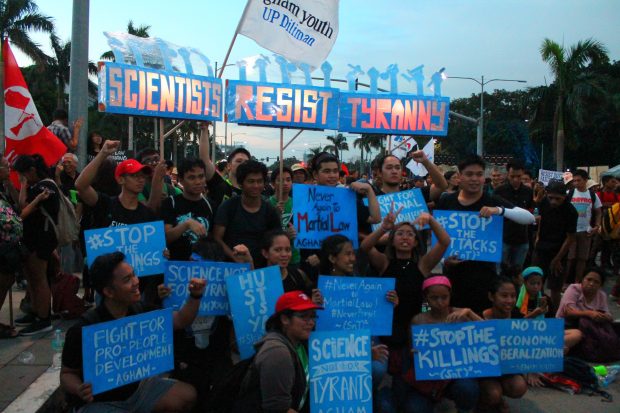
Muling gumawa ng kasaysayan ang sambayanang Pilipino noong nakaraang Biyernes, kung saan kasama ng kabataan ang iba’t ibang sektor ng lipunan upang gunitain ang ika-46 anibersaryo ng batas militar sa Pilipinas sa ilalim ng diktador na si Ferdinand E. Marcos. Taas-kamaong pinagpugayan ng sambayanan ang mga taong naglaan ng kanilang mga buhay upang labanan ang diktadurya at tiraniya noong panahong iyon.
Isa si Andrew Mencias, 20, sa naitalang labinlimang-libong nagprotesta sa Luneta. Kasama ang kanyang mga kaibigan mula UP Diliman ay tumungo siya sa Luneta upang sumama sa mas malawak na hanay ng mamamayan. Kasabay ng pag-alala sa kamatayan ng demokrasya ay ang pagkundena sa nagbabadyang pagbabalik ng pamilyang Marcos sa mas mataas na kapangyarihang politikal at ang patuloy na pagtapak sa karapatang pantao ng kasalukuyang administrasyongRodrigo Duterte.
“Pumunta ako ng Luneta dahil naniniwala ako sa kahalagahan ng sama-samang pagkilos,” ani Mencias. “Para sa akin, maraming bagay tayong dapat nating natatamasa pero hindi natin nakukuha.”
Nagkataong itinakda din noong nakaraang Biyernes ang Pandaigdigang Araw ng Kapayapaan, ngunit isa itong malaking kabalintunaan sa ating bansa. Sa araw na ito’y binabalikan ng sambayanan ang taong 1972, kung kailan tinanggal ang kalayaan ng mamamayan. Kung iisipi’y ilang dekada nang lumipas, subalit muli itong nagiging tampok ngayon kaugnay ng pamamalakad ng administrasyong Duterte, na inihahalintulad ng mga grupong sektoral kay Marcos.
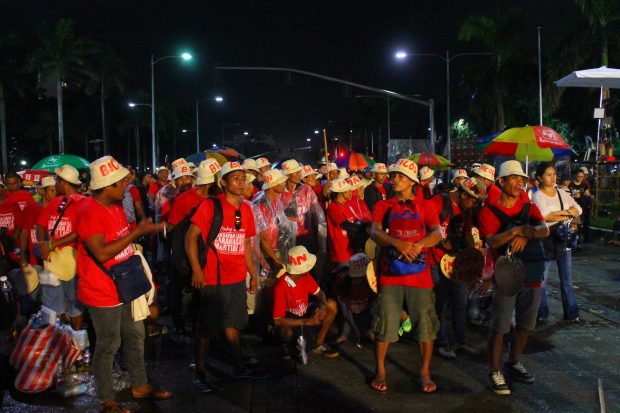 Patuloy ang pagnupuna at pagkukundena ng iba’t ibang mga grupo sa kasalukuyang administrasyon dahil sa kawalang-respeto nito sa karapatang pantao at ang patuloy na pagsasabatas ng mga anti-mamamayang polisiya. Aktibong lumalahok sa mga pagkilos ang kabataan—kasabay ng pagsama sa iba’t ibang mobilisasyon ay ang pagsulong ng kanilang mga adbokasiya bilang tugon sa iba’t ibang isyung panlipunan.
Patuloy ang pagnupuna at pagkukundena ng iba’t ibang mga grupo sa kasalukuyang administrasyon dahil sa kawalang-respeto nito sa karapatang pantao at ang patuloy na pagsasabatas ng mga anti-mamamayang polisiya. Aktibong lumalahok sa mga pagkilos ang kabataan—kasabay ng pagsama sa iba’t ibang mobilisasyon ay ang pagsulong ng kanilang mga adbokasiya bilang tugon sa iba’t ibang isyung panlipunan.
Katulad na lamang ni Mencias na nakikiisa sa laban ng kabataan para sa libreng edukasyon, na itinuturing niyang pundasyon ng isang progresibong lipunan. Habang malayo na ang narating ng kampanya, patuloy pa rin ang mga dagok na humahadlang upang makamit ang edukasyon para sa lahat.
“Nakakalungkot na pangit yung quality ng maraming public schools dito sa atin,” ani Mencias. “Nakakulong pa rin tayo sa isang sistemang wala tayong napapala.”
Kamakailan lamang ay napagtagumpayan ng kabataan na tanggalin ang Return Service Agreement mula sa Implementing Rules and Regulations (IRR) ng RA 10931 o ang Universal Access to Quality Tertiary Education Act of 2017. Matagal nang pinupuna ng mga estudyante ang probisyong ito—ayon sa National Union of Students of the Philippines (NUSP), ang edukasyon ay karapatan at dapat walang kapalit.
Gayunpaman, sa maliliit na hakbang ay patuloy pa rin ang mga banta sa karapatang ito, katulad ng nagbabadyang budget cut sa edukasyon at ang pasuweldo sa mga guro na hindi pa rin sapat.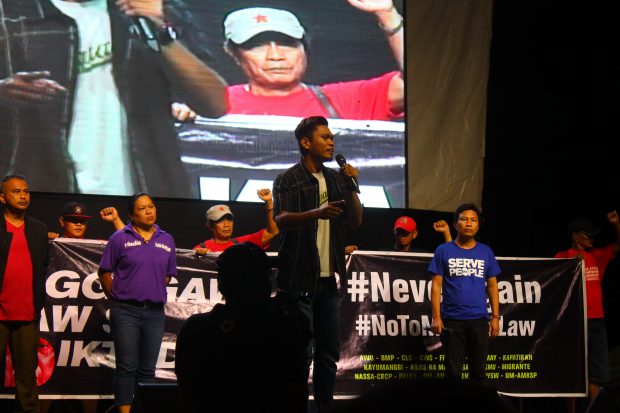
Isa pa sa isinusulong ni Mencias ay ang karapatan ng pambansang minorya, na patuloy na binubusabos ng kasalukuyang rehimen. “Higit sa lahat, sila yung pinaka-apektado ng mga batas, at hindi rin naman sila pinoprotektahan ng military,” ani Mencias.
Ayon sa Save our Schools (SOS) Network, kamakailan lamang ay pitong kabataang Moro ang pinatay ng mga militar sa Patikul, Sulu sa ilalim ng batas militar sa Mindanao—bukod pa dito ay ang serye ng mga pagbomba sa mga katutubong komunidad at mga kaso ng puwersahang pagsuko sa kamay ng mga puwersang gobyerno, isang manipestasyon na patuloy pa rin ang paglabag ng estado sa karapatang pantao.
Isang patunay si Mencias sa libo-libong kabataang patuloy na nakikibaka para sa tunay na pagbabagong panlipunan at tumatangging kalimutan ang ating masalimuot na nakaraan. Patuloy nilang ginagampanan ang kanilang papel bilang mga pag-asa ng bayan. Ang sabi ng iilan, huwag nang mangialam ang kabataan, hindi naman kayo buhay noong mga panahong iyon.
Ngunit sila’y hindi magpapatinag.
“Hanggang ngayon naman, nararamdaman pa rin natin ang mga ginawa ni Marcos, ngayon pang gusto nilang bumalik sa mataas na kapangyarihan,” ani Mencias. “Dapat naman talaga nating binabalikan at pinag-uusapan ang kasaysayan, para maisakonteksto natin yung sitwasyon na meron tayo ngayon.”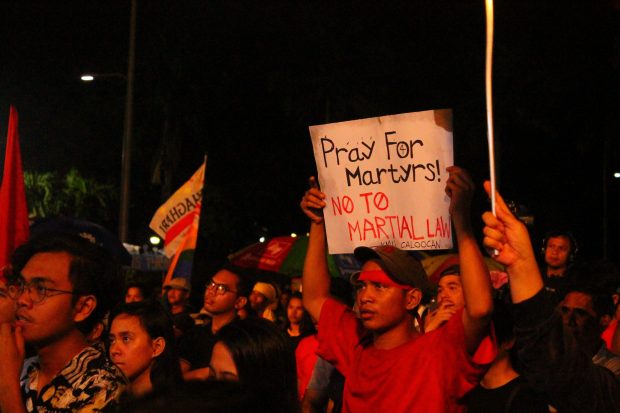
Kung babalikan ang 1970, ang kabataan ang nanguna sa panawagang baguhin ang sistemang pulitikal at pang-ekonomiko ng bansa. Sa Sigwa ng Unang Kwarto, kabataan ang nanguna sa paghingi ng pagbabagong panlipunan sa ilalim ng administrasyong Marcos, na nagpapakita na ng mga tendensiyang diktaduriyal. Maraming kabataan ang nagbuwis ng buhay upang ipaglaban ang kinabukasan ng inang bayan.
Halos limang dekada na ang lumipas, ngunit muli nilang pinatunayang patuloy silang lumalaban kasama ang sambayanan.
Hindi pa rin nagbabago ang lipunang ginagalawan—sa ilalim ng administrasyong Duterte, kinikitil ang mga pag-asa ng bayan at pilit pinipinturahan ito ng estado bilang “collateral damage”. Nariyan si Kian delos Santos, si Carl Arnaiz, at daan-daang kabataang biktima ng pambubusabos at paglabag sa karapatang pantao ng kasalukuyang liderato.
Ganoon pa rin ang sistemang pulitikal at pang-ekonomiko na patuloy na pinoprotektahan lamang ang interes ng makapangyarihang iilan. Patuloy ang pagtatangkang baguhin ang kasaysayan at ilagay sa pedestal ang diktador na kumitil ng maraming buhay at binaon ang bansa sa utang na hanggang ngayo’y pasanin ng mamamayan.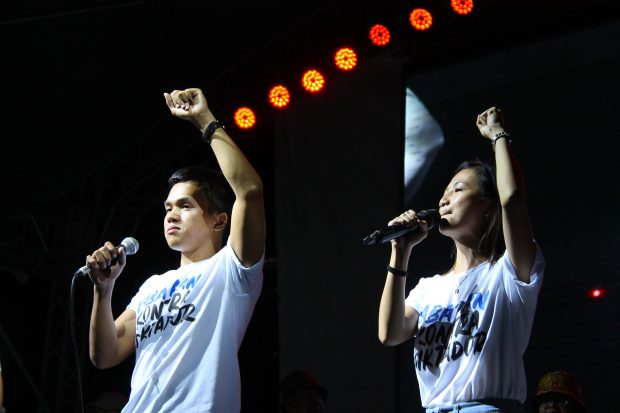
Patuloy pa rin ang laban.
Madalas na tinuturo sa mga paaralan na nakamtam muli ng sambayanan ang kalayaan matapos nilang pabagsakin ang diktadurya noong 1986. Ngunit alam ng kabataang hindi pa tunay na malaya ang bansa—mahaba lang ang tanikala. Sila ang patunay na hindi maaaring magbulag-bulagan ang mamamayan, lalo’t harap-harapan ang paglabag at ang pagsasawalang-bahala.
Ilang buhay man ang kunin, patuloy silang babalik at lalaban. #
By Luis V. Teodoro
Despite the bluster of President Rodrigo Duterte and his equally loud lieutenants, yes-men and accomplices in the Cabinet, the House of Representatives, the Senate, and the Supreme Court, his regime is in reality completely without anything that even approximates a rational and coherent platform of governance. It is making things up as it goes along, and patching together ad hoc attempts to make it seem as if it were addressing the urgent problems that haunt the nation, most of which are of its own making.
But there is some method in this seeming madness. Devising the right solutions to the country’s problems is not only beyond the regime’s capacity; it is also the last of its priorities. What it craves most is absolute power and political dominance, to achieve which it uses the most absurd and politically self-damaging means to silence and suppress its critics as well as anyone else opposed to — among its legions of offenses against this portion of humanity — its lawlessness and contempt for human rights, and the terrible cost in lives of its savage “war” on drugs.
To achieve that dominance it has demonized and threatened the independent press, and elevated as policy the use of coercion against dissenters including the manufacture of various forms of deception to imprison its perceived enemies.
Both are failing, however, and have become counterproductive. The threats on the press are uniting much of the media community behind the imperative of defending its constitutionally-protected freedom as well as free expression. Its latest attempt to jail another political opponent, Senator Antonio Trillanes IV, has instead enhanced Trillanes’ status as a leader of the political opposition by keeping him in the media limelight and providing him a forum from which to address the public and condemn the many failings of the regime that’s persecuting him.
In obvious recognition of how much its mindless attack on Trillanes has earned him near-unprecedented media mileage, the regime launched a media campaign that began with that misnamed September 11 “tête-à-tête” between Mr. Duterte and his legal counsel. In the public mind that event seemed so much like a conversation solely between Mr. Duterte and himself that few took seriously even his claim that there was a conspiracy afoot to oust him from power.
Its obvious and desperate attempts to preserve and enhance what it mistakenly believes should be permanent citizen approval of anything and everything it says or does, and its egregious failure to even begin to address the problems its own lack of vision and ineptitude created, have led some observers to conclude that it’s only a matter of time before the regime collapses from the dead-weight of its own blunders and ineptitude.
There is indeed that inviting possibility. But it would be a mistake to underestimate the regime capacity to inflict irreparable harm on this country and its people before it finally goes. For if at all it has any semblance of a plan, it is to transform the Duterte dynasty from a petty rural tyranny to a national dictatorship — a process that thanks to the perverse character of Philippine elections as a media and popularity contest began in 2016, when the electorate catapulted a provincial despot to national office. Only by putting the entire country under authoritarian rule can it protect and preserve the dynasty’s long-term interests.
A third of the Philippines is still under martial law 32 years after the fall of the Marcos terror regime in 1986, and despite the lessons from that dark period that every Filipino should have learned by now.
Because Mindanao is the laboratory in which the regime is testing the feasibility of placing the entire Philippines under one-man rule, martial law has twice been extended by a Congress and Supreme Court dominated by landlords, their hirelings, and by bureaucrats with neither a sense of history nor concern for the rights and liberties of the people. It is likely to be extended for the third time on the argument that it is needed to check the violence it has failed to prevent — and of which its military and police implementors are often the perpetrators.
As distressing as this may be, what is even more abhorrent is the growth of the myth that the Marcos version of martial law ushered in some kind of Golden Age in the troubled history of this Republic. There is also the growing popularity of the dangerous notion that the nationwide imposition of martial rule is a legitimate government option, and its acceptance by regime partisans as a supposed means of ending criminality and the drug problem that Duterte the candidate promised in 2016.
The by now conventional view is that these delusions are among the consequences of the failure of those who lived through the terrors of the Marcos dictatorship to pass on to succeeding generations what authoritarian rule meant to the hundreds of thousands who were its victims as well as its immediate and long-term impact on the present and future of this country and its people.
There is much that is true in that explanation. But those falsehoods are also the results of a campaign in which the Marcos, Arroyo and kindred dynasties are not only willing collaborators but also the driving forces, to prettify fascist rule and pass it off as the only means of bringing about the changes that have eluded the Filipino people for centuries.
This is the context in which the current President of the Philippines has been making his frequent promises to resign. Is the goal — and Mr. Duterte has hardly tried to conceal it — for him to relinquish the Presidency once Ferdinand “Bongbong” Marcos, Jr. is declared by the Supreme Court, while sitting as the Presidential Electoral Tribunal (PET), Vice President in place of Maria Leonor “Leni” Robredo?
If this is indeed the plan, Marcos, Jr. would be interim President until 2022, from the commanding heights of which he could then complete Mr. Duterte’s march to despotism, thus clearing his daughter Sara Duterte-Carpio’s path to the Presidency.
The catch in this seemingly clever scheme is that the Marcoses’ agenda is entirely different from that of the Dutertes. Marcos, Jr. as well as his mother Imelda, his sisters, and the rest of the Romualdez and Marcos clans have made it abundantly clear that they want “Bongbong” to be President to complete their return to the pinnacles of power, from where they can foist upon the people their version of what happened during the 21-year rule of their late patriarch.
Therein lies the fatal flaw in this conspiracy against the country, the Constitution and the Filipino people. There is every likelihood that as in times past, the alliances of convenience forged among the ruling cliques in this vale of uncertainty will come apart under the pressure of their unremitting greed for pelf and power.
Their differences can find expression in the armed confrontations and assassinations that still characterize much of local politics, and which have numerous times spilled into the national arena. The ensuing violence would then be part of the already bloody legacy the Duterte regime will leave behind once it passes into history.
(First published in BusinessWorld. Photo from PCOO)
